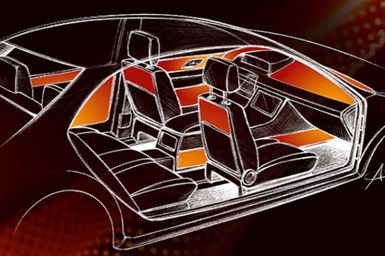New EV Heating Concept is on the Money
Partners aim to extend driving range by supplementing HVAC system
#hybrid
Simply throwing money at a problem usually doesn’t work out well.
But applying focused engineering knowhow can yield innovative results, even when it comes from unexpected sources—including those whose primary business is money.
To this end, engineering specialist IAV Group has teamed up with a non-traditional partner to develop a new way to heat passenger compartments and boost the driving range of electric vehicles.
In this case, the partner is Louisenthal, which is a subsidiary of the Giesecke+Devrient Currency Technology. The German company is one of the leading developers and suppliers of banknotes (including the euro) and security paper. It literally prints money for governments and central banks worldwide.
Foiling EV Heating
Louisenthal also has an industrial applications division, which developed a conductive foil that can be installed underneath plastic components to quickly heat car interiors.

Embedded SmartMesh foils can help heat interiors. (Image: Louisenthal)
IAV, which is working with Louisenthal to adapt and validate the technology for vehicles, says simulations have shown the system can reduce the amount of energy required to heat the passenger compartment by as much as 20%.
In an EV, the improved efficiency can extend driving range by as much as 6%, according to the partners.
How It Works
Dubbed SmartMesh, the system embeds a network of conductive tracks into the foil. As voltage is applied, the mesh quickly warms up and radiates heat.
The partners claim the system does the job more efficiently than current HVAC systems, which can significantly reduce driving ranges in cold weather.
The thin mesh film can be easily applied within PET and polycarbonate parts, including door panels, the center console and roof liner, Louisenthal says. Another plus: The transparent design allows the technology to be combined with ambient lighting and other LED elements.
What’s Next?
The partners, which are talking with several potential customers, describe the system as a cost-effective way to improve an EV’s efficiency and supplement existing HVAC systems.
“We can produce the SmartMesh foils on an industrial scale in large quantities, providing an energy-saving and more convenient addition to conventional heating systems for future electric vehicle concepts,” says Daniel Lenssen, Louisenthal’s director of business development.
Other potential vehicle applications include using SmartMesh to defrost windshields, exterior lights and ADAS sensors. Louisenthal also is targeting smart window systems in homes and other buildings.
No timeline for commercialization was provided.
RELATED CONTENT
-
Frito-Lay, Transportation and the Environment
Addressing greenhouse gas reduction in the snack food supply chain
-
On Automotive: An All Electric Edition
A look at electric vehicle-related developments, from new products to recycling old batteries.
-
Special Report: Toyota & Issues Electric
Although Toyota’s focus on hybrid powertrains at the seeming expense of the development of a portfolio of full battery electric vehicles (BEVs) for the market could cause some concern among those of an environmental orientation, in that Toyota doesn’t seem to be sufficiently supportive of the environment, in their estimation. Here’s something that could cause a reconsideration of that point of view.








